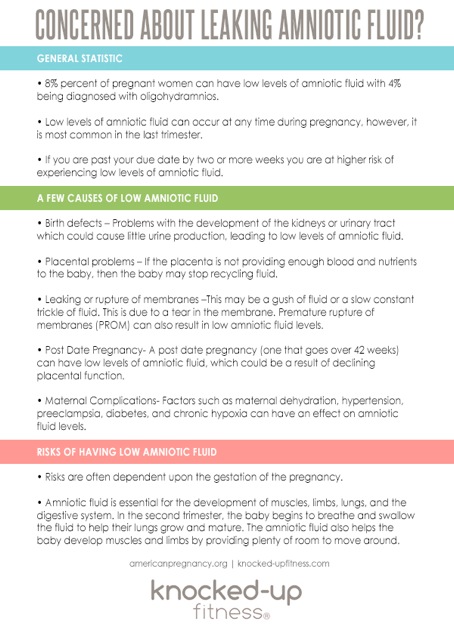Whether you are a first time mom or have experienced a prior pregnancy I want to talk about something that many expecting moms don’t give a lot of thought to…amniotic fluid.
I want to discuss amniotic fluid and the dangers of low amniotic fluid (which isn’t very common but it does happen). Is yours sufficient? How would you be able to tell? When is it time to discuss this with your mid-wife or doctor any changes you have noticed with discharge?
I will be providing some hints to determine if you are working with low fluid and whether or not you may be leaking it!
Being that I just experienced my first pregnancy I had no idea, for some time, that what I was experiencing “down there” was in fact something that needed to be not only discussed with my mid-wife but also addressed much sooner than it was!
I had been to multiple appointments, had my scheduled sonograms, progressed from hearing the baby’s heart beat every few weeks to every two and then towards the end every week with no CLUE that I was slowly leaking amniotic fluid!
Some of you may be wondering how in the world I didn’t catch on to the fact that I had little to no fluid. However, when you are making it to each appointment and your mid-wife is giving you the OK on everything why would one think that the “damp” feeling I was experiencing each and every day as I was changing my undergarments would be anything other than the “normal” pregnancy discharge that ALL pregnant women experience.
My condition was caught right in the nick of time. Luckily, I had a breech baby.. you won’t be hearing many women feeling lucky about a breech baby!! So at 36 weeks I had an appointment to get a “version” done, a procedure in which a physician attempts to manually turn the baby from a head up to a head down position in an effort to give mom and baby the opportunity to have a vaginal delivery.
As is common protocol, prior to starting the procedure I was scheduled for a sonogram. This was utilized to ensure that the baby was still breech and to determine that I had sufficient amniotic fluid to turn the baby.
As many mothers know, a sonogram is a simple, painless, and relatively quick procedure. However, a telltale sign that something of concern may be happening, is when you have a sonographer leave the room multiple times to eventually return with the physician scheduled to do your procedure.
In a matter of minutes, I went from having the “version” schedule to having an emergency C-section. I had ONE 2 cm pocket of amniotic fluid (Just a side note the threshold in which many OB’s start to monitor fluid levels is 5 cm).
Although, at the moment, this was not welcomed news for many reasons obviously, primarily due to the fact that I wanted nothing more than to have a vaginal delivery retrospectively, I am quite blessed that it was caught.
After my baby had been safely delivered and I had adjusted to my new reality of being a mommy I started to get curious and ask the “who, what, when, where, how, and why” of this happening.
Below I have provided some general guidelines to consider if you are an expecting mom and at any point if you feel like the “damp down there” has changed or feels off I would encourage you to listen to your intuition, as no one knows your body better than you, and bring it up with your health care provider.
I, unfortunately, experienced placental problems in which the placenta was not providing enough blood or nutrients to the baby to the point at which it was picked up on the sonogram (the good news is, it can be picked up on a sonogram!!). It was concluded that this was caused by a small leak due to a rupture of the membranes causing a slow constant trickle of fluid resulting in a constant “damp” feeling.
So how can you tell if you MAY be leaking amniotic fluid?!
Honestly, it can be difficult to determine! During the third trimester the baby will put increasing amounts of pressure on the body, causing discharge to fall from the cervix. You may also begin to leak urine as the uterus puts additional pressure on the bladder.
Unlike these substances, amniotic fluid is odorless and will soak the undergarments as it leaks in a significant amount. Urine and cervical discharge occur in “spurts.”
For me, it became a nightly routine to remove undergarments that were dampened (not wet) all the way through. I attributed this to sweat and discharge only to now know this is one of the best indicators that you are indeed leaking fluid.
Also, I did notice that when I would rub my growing belly I didn’t feel the typical “squish” many women had due to the padding provided by the amniotic fluid however, with no previous pregnancies to compare this to I thought little of it!
Utilizing a sanitary napkin can be helpful in determining the amount and type of fluid you are leaking. However, my best advice to expecting moms is to pay attention and be aware!! As I said previously, no one knows your body better than you!
It is important to note that this was not due to the fact that I stayed active throughout my pregnancy! However, I also encourage you to stay hydrated!! It is so important not only for your overall health but the health of your baby.
Discuss any changes you pick up on with your health care provider!
Other related Knocked-Up Fitness and Wellness posts:


